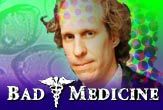Dry Cleaning's Dirty Trick

In most big cities you will see drycleaners attempting to go green. For many, though, green refers to money, not environmental consciousness.
There's a curious sign in the storefronts of many drycleaners boasting of a new "organic" cleaning technique that is non-toxic and environmentally benign. Clearly they are trying to capitalize on the consumers' pursuit of all things wholesome.
The new cleaning fluid they are using, called DF-2000, is indeed very organic, as organic as gasoline and every major dry-cleaning fluid since the creation of the industry 150 years ago. After all, to a chemist, a chemical is organic if it contains a chain of carbon.
DF-2000 is made by Exxon-Mobil, those stewards of the environment who dumped 30 million gallons of crude oil—the precursor to gasoline and, yes, DF-2000—onto the shoreline of Alaska in 1989 and are still in court today bickering over the fine. How anything with the industrial-sounding name "DF-2000" could be construed as organic in the "all-natural" sense is beyond me.
Semantics aside, the toxic DF-2000 is safe only in comparison to what it hopes to replace.
Trying to come clean
The fluid used by more than 85 percent of U.S. drycleaners is truly nasty stuff called perchloroethylene, or perc, classified as a probable human cancer-causing chemical by the Environmental Protection Agency. Perc is organic, too.
Sign up for the Live Science daily newsletter now
Get the world’s most fascinating discoveries delivered straight to your inbox.
Last week California announced a plan to phase out perc by 2023, with a ban on new perc equipment in effect by next year. The chemical poses little immediate health risk to most customers aside from rashes for those with sensitive skin. Workers have long been at risk, though, and the National Institute for Occupational Safety and Health has found evidence of elevated cancer and death rates.
Perc isn't so good for the environment, either. According to Greenpeace, 70 percent of the fluid winds up in the air or in ground water. We all ingest the stuff one way or another, although the long-term health implications are not known.
California's new law doesn't specify what should replace perc. Several good alternatives exist, but DF-2000 is best positioned to be the solvent of choice for cash-strapped ma-and-pa drycleaners based on price and ease of use.
Out with the old, in with the older
Dry cleaning isn't dry; it merely uses a solvent instead of water to clean. In the mid-1800s, a Frenchman named Jean Baptiste Jolly noticed that kerosene accidentally spilled on a tablecloth made it cleaner. And an industry of dangerous, smelly cleaning fluids was born.
Organic solvents don't bind to fibers the way water does and therefore don't wrinkle or scrunch delicate fabrics. Up until World War II, most cleaning fluids were petroleum-based, such as the widely used Stoddard solvent. The problem with them, aside from causing dizziness or neurological disorders, was that they sort of exploded if they got too hot. Perc was a godsend: nonflammable, not as smelly, and the best solvent known for removing dirt.
DF-2000 is similar to Stoddard solvent, only with a higher flashpoint (meaning less of a tendency to explode if exposed to a spark). The EPA lists DF-2000 as a neurotoxin and skin and eye irritant for workers; and its use can contribute to smog and global warming, just like Stoddard solvent.
For the environmentally conscious
While DF-2000 is likely at least marginally better than perc in terms of health and environment, it is not green. Marketing DF-2000 as organic—a scheme apparently devised by dry-cleaning associations, not Exxon-Mobile—is shameless.
Much farther up the green ladder are dry-cleaning techniques using carbon dioxide and, of all things, water. Alas, the processes involving them cost more money.
Nearly all garments labeled "dry clean only" can be cleaned with water through a process called wet-cleaning. This takes time and skill on the part of the professional, hence the higher price. The carbon dioxide method involves liquid CO2 under high pressure. Here, the machines are expensive and often require licensing fees.
Kermit the Frog once sang that it's not easy being green. Perhaps that's why some drycleaners merely post a sign pretending to be green.
Christopher Wanjek is the author of the books “Bad Medicine” and “Food At Work.” Got a question about Bad Medicine? Email Wanjek. If it’s really bad, he just might answer it in a future column. Bad Medicine appears each Tuesday on LIveScience.

Christopher Wanjek is a Live Science contributor and a health and science writer. He is the author of three science books: Spacefarers (2020), Food at Work (2005) and Bad Medicine (2003). His "Food at Work" book and project, concerning workers' health, safety and productivity, was commissioned by the U.N.'s International Labor Organization. For Live Science, Christopher covers public health, nutrition and biology, and he has written extensively for The Washington Post and Sky & Telescope among others, as well as for the NASA Goddard Space Flight Center, where he was a senior writer. Christopher holds a Master of Health degree from Harvard School of Public Health and a degree in journalism from Temple University.
